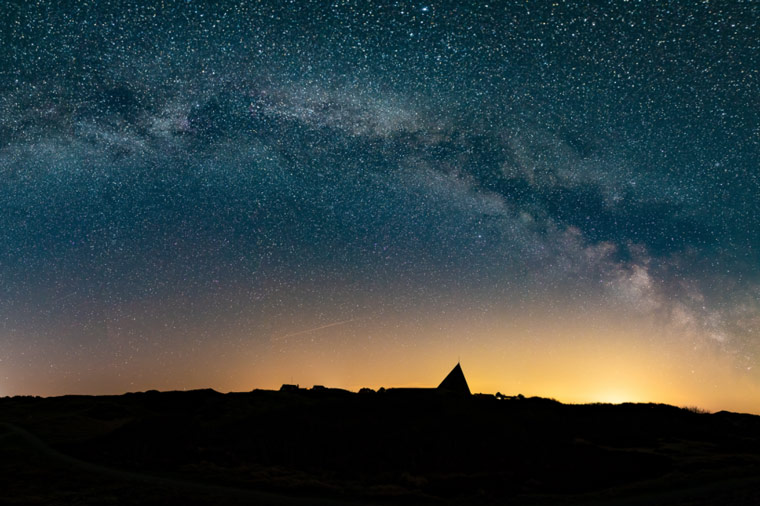Spiekeroog and the Milky Way over the island. Picture credit: Kai Kröger
WADDEN SEA, Germany — The islands of Pellworm and Spiekeroog in the UNESCO World Heritage Wadden Sea are now recognized as Star Islands (Sterneninsel in German) and International Dark Sky Communities by the International Dark-Sky Association (IDA). The two islands, Pellworm in the Schleswig-Holstein Wadden Sea and Spiekeroog in the Lower Saxony Wadden Sea, still offer a natural night landscape with a dark, starry night sky. In order to preserve the quality of night skies in this region, the two islands set out to be model examples for the protection of the night through appropriate lighting.
Ministers of the Environment of the participating countries within the Wadden Sea Region started this movement by calling for the reduction of light emissions in 2018 in the Intergovernmental Conference on the Protection of the Wadden Sea. From there, a partnership between Denmark, Germany, and the Netherlands was formed to protect the night sky and improve the experiences of dark nights and skies in the Wadden Sea Region, which already includes Lauwersmeer National Park and De Boschplaat (Terschelling) in the Netherlands as International Dark Sky Parks.
“I am extremely pleased that Pellworm has now been recognized by the IDA as the first International Dark Sky Place in Schleswig-Holstein,” stated Sarah Michna, Director of the Tourism and Health Resort of Pellworm. “We made a conscious decision to pursue the certification as a Star Island. Thus, we understand the acknowledgment serves not only as an appreciation of our work, but also as preservation of the darkness with all of its positive effects on humans and nature to carry further. On behalf of the entire Star Island project group, I would like to express my sincere thanks for the support of the IDA Dark Sky Places Committee for their recognition of Pellworm Star Island as an International Dark Sky Community.”
“It is wonderful to see the continued efforts to protect the nocturnal environment in this distinct, pristine, and essential natural area,” stated Ruskin Hartley, Executive Director of the IDA. “The partnerships and cooperation between these parks and communities will only strengthen the effort to provide substantial opportunities for interacting with and experiencing a starry nightscape.”
To obtain the certificate, the islands’ parliaments adopted lighting guidelines that meet IDA’s Community requirements. For example, “warm” color temperatures and the lowest possible amount of light should be selected, and artificial light should only be used as needed.
Both communities implemented retrofit projects to demonstrate their understanding and commitment to effective and community-friendly outdoor lighting. Pellworm accomplished this task with funding from the LEADER project AktivRegion Uthlande to retrofit a total of 140 street lights with 2200K LED, fully shielded fixtures. While Spiekeroog recently purchased 3000K and seemingly overly bright fixtures, their mayor Matthias Piszczan was able to reprogram all 68 luminaires to reduce the driver current by 30%, resulting in less glare, a longer lifetime of the LED fixtures, and conformity to IDA’s guidelines.
These measures will also reduce energy consumption, and thus carbon dioxide emissions. At the same time, artificial lighting suitable for species protection, such as for the millions of seabirds that migrate to roost on Pellworm, is implemented in accordance with the current version of the Federal Nature Conservation Act.
Sky brightness measurements were also taken for the nomination, which showed that the two islands are indeed among the darkest regions in Germany, with zenith night sky brightness values between 21.5 mag/sq arcsec in nights with higher humidity and as dark as 22.0 mag/sq arcsec in exceptionally clear and dark nights.
The benefits of low light pollution and impressive starry skies are communicated to the local population and visitors through public relations efforts. For example, guided star tours are regularly offered and coincide with the existing tourism industry. As a result, Pellworm Star Island is one of five candidates nominated for Schleswig-Holstein Tourism Agency’s ADAC Tourism Award 2021. Additionally, with the help of the Wittbülten National Park House, the Lower Saxony Wadden Sea National Park Authority has set up three observation sites on Spiekeroog that illustrate different light situations. A platform with loungers and supports for stargazing was installed at a “Sternkieker” site. The spa administration also supports the project with communication tools, events, and other services for guests and islanders.
Pellworms Star Island’s website can be found at https://www.pellworm.de/sterneninsel/.
Spiekeroogs Star Island’s website can be found at https://www.spiekeroog.de/sterneninsel/.
Tagged with dark sky, lightED